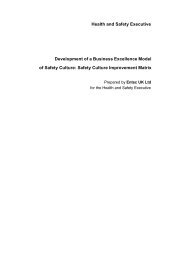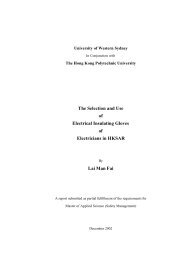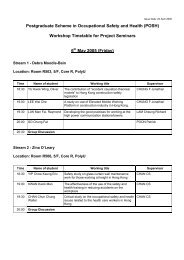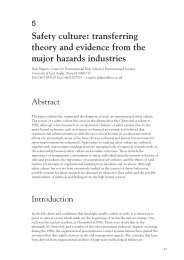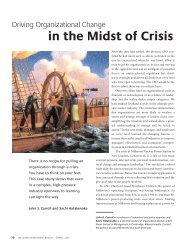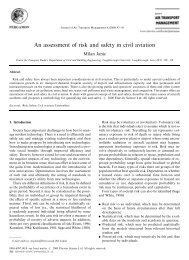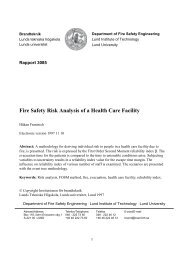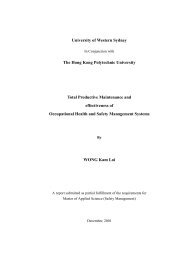Assessing safety culture in offshore environments - Industrial Centre
Assessing safety culture in offshore environments - Industrial Centre
Assessing safety culture in offshore environments - Industrial Centre
You also want an ePaper? Increase the reach of your titles
YUMPU automatically turns print PDFs into web optimized ePapers that Google loves.
employed here for two reasons: (1) to elicit constructs based on <strong>in</strong>dividuals' notionsof `<strong>safety</strong> <strong>culture</strong>'; and (2) to provide <strong>in</strong>itial <strong>in</strong>dications of any di€erences <strong>in</strong> overallperceptions between di€erent work groups <strong>in</strong> the study organisations. The focusgroup studies were deemed to be particularly appropriate at this stage of the <strong>in</strong>vestigationss<strong>in</strong>ce the data collected would be utilised as the basis for the toolkit developmentand, <strong>in</strong> particular, the development of the questionnaire tool. Focus groupsas a method are well accepted (Krueger, 1994) but they can be biased by a numberof factors, e.g. dom<strong>in</strong>ation of the group by one member or too much direction bythe facilitator. These biases were controlled for by the use of a small number ofgroup facilitators who followed a structured discussion format.2.1. MethodA series of focus group discussions (n=40) were conducted us<strong>in</strong>g both o€shoreand onshore personnel <strong>in</strong> three separate organisations, at a total of six di€erentlocations. These 40 discussion groups <strong>in</strong>volved 375 employees <strong>in</strong> groups rang<strong>in</strong>gbetween three and 12 <strong>in</strong>dividuals. One hundred and eighty-one participants worked<strong>in</strong> onshore locations and 194 were based on o€shore <strong>in</strong>stallations. Eighty-threemanagers and supervisors took part <strong>in</strong> the study. Wherever possible the groups werehomogenous and comprised either: (1) managers and supervisors; or (2) members ofthe workforce. This promoted an atmosphere of open enquiry and, wherever possible,avoided <strong>in</strong>hibit<strong>in</strong>g the group members (Carroll, 1998).Each of the discussions <strong>in</strong>volved four questions be<strong>in</strong>g put to the group participants,namely what they understood by the term <strong>safety</strong>, what they understood bythe term company <strong>culture</strong>, how <strong>safety</strong> ®ts <strong>in</strong>to their picture of company <strong>culture</strong> andwhat they understood by the term <strong>safety</strong> <strong>culture</strong>. The ®rst three questions weredesigned to put participants at their ease and help focus their discussion of theconcept of <strong>safety</strong> <strong>culture</strong>. All members of the group were encouraged by the facilitatorto make a response to the ®nal question.Each of the focus group discussions were recorded on audiotape and then transcribedverbatim. These transcriptions were then subjected to a prelim<strong>in</strong>ary contentanalysis (Holsti, 1969; Dane, 1990) <strong>in</strong>volv<strong>in</strong>g two <strong>in</strong>dependent raters, and theresult<strong>in</strong>g keywords (based on the most commonly occurr<strong>in</strong>g constructs <strong>in</strong> the discussionsof the concept of <strong>safety</strong> <strong>culture</strong>) were tabulated. There was 96% agreementbetween raters on the classi®cation of concepts. Where the raters did not agree onthe categorisation of a concept (<strong>in</strong> 13 cases), a third rater arbitrated. In addition tothe extraction of <strong>in</strong>dividual key constructs, general group feel<strong>in</strong>gs and perceptions of<strong>safety</strong> were recorded as appropriate.2.2. ResultsS.J. Cox, A.J.T. Cheyne / Safety Science 34 (2000) 111±129 117All groups actively participated with a good degree of co-operation. The numberof occasions each concept was mentioned dur<strong>in</strong>g the focus discussion groups isshown <strong>in</strong> Table 1, together with a breakdown by organisation. The numbers shown<strong>in</strong> brackets <strong>in</strong>dicate the number of times each issue was raised <strong>in</strong> a negative sense.




